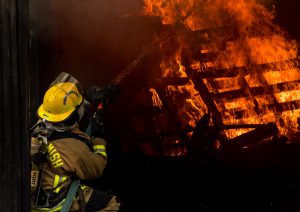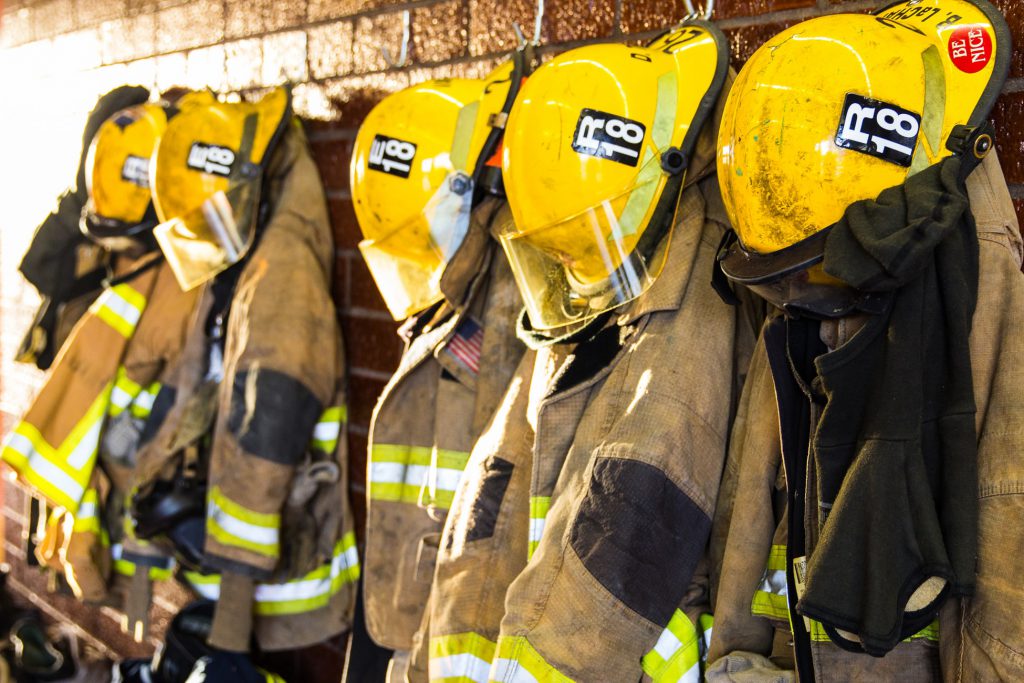Firefighters face chemical exposure in their gear
By Sarah Mandile

As firefighters put themselves at risk battling angry, hot flames, an unseen danger also threatens them.
This danger comes in the form of toxic chemicals known as PFAS. The chemicals are found in firefighting foam as well as in firefighters’ personal protective gear.
Like its presence in drinking water, PFAS in firefighting foam has gained more attention over the years. The Department of Defense must phase PFAS out of the foam by October 2024. However, the presence of PFAS in firefighters’ protective gear is less well-known.
This gear, also known as turnout gear, includes the pants, boots, jacket and other safety gear firefighters wear to protect themselves from heat when they step up to a burning building.
First developed in the 1940s, PFAS are the most persistent synthetic chemicals to date. Because of their long half-life, they have been nicknamed “forever chemicals.” They are so widespread that they appear in the blood of mother and cub polar bears.
In people, PFAS are linked to increased cancer risk and other adverse health effects. Beyond direct exposure, they are also passed from mothers to their children during pregnancy. In these situations, PFAS have been shown to link with a low birth rate in infants as well as obesity and diabetes later in life.
PFAS in firefighting foam
The danger of forever chemicals to firefighters first emerged around a kind of firefighting foam. So called “aqueous film-forming foam” is used to extinguish hydrocarbon fuel fires, according to the U.S Naval Research Laboratory.
This firefighting foam works by forming a film on the fuel surface that prevents evaporation and reignition of the fuel.
According to the Environmental Working Group, firefighting foam is one of the most significant sources of water contamination from PFAS.
This foam has been used frequently by the military, fire training centers, and airports even though military studies showed as early as the 1970s that they are toxic and dangerous.
Studies have shown that firefighters tested had blood levels of PFAS-related chemicals higher than the general population.
As firefighters continue to be exposed, PFAS are absorbed and accumulate in their body, making them more susceptible to cancer and thyroid hormone disruption. In 2018, Congress passed and President Trump signed into law a new firefighter cancer registry to collect data on cancer incidence, but it is not yet up and running.
Melanie Benesh, legislative attorney for the Environmental Working Group, said lots of attention has been given to the issue of firefighting foam because of the huge amounts that end up contaminating drinking water. When firefighters use firefighting foam, gallons at a time end up in surrounding water sources. Yet the contamination firefighters are exposed to in the gear has drawn less attention.

Protecting the Protectors:
Tips for firefighters
- Only wear turnout gear when necessary
- Have the gear professionally cleaned (One study found levels of PFOA were higher in firefighters who hadn’t had their gear professionally cleaned in the last year.)
- Keep turnout gear out of living areas of the fire station to limit exposure
- Wash and bag dirty gear immediately after leaving a fire scene where firefighting foam was used
- Shower as soon as possible after exposure to firefighting foam
PFAS found in firefighting gear
In 2014, Paul Cotter was diagnosed with prostate cancer and forced to retire from his 28-year career with the Worchester Fire Department in Massachusetts. His illness led his wife, Diane Cotter, to begin asking questions.
She then stumbled upon something that caught her attention, an article about a recall in malfunctioning protective firefighter gear.
The more she looked into firefighting turnout gear, the more Cotter began to learn about PFAS.
Her investigations led her to a nuclear physicist at Notre Dame University named Graham Peaslee. He conducted a study, the first of its kind, on old and new firefighting gear.
Peaslee discovered that most of the gear he observed, old and new donated by a variety of firefighters, was manufactured similarly because of an National Fire Protection Agency 1971 standard. PFAS were used for water and oil resistance because if the 30-pound gear were to get wet, it would be even heavier than it already is. The chemicals not only protect firefighters from scorching flames, but ensure their gear doesn’t become impossibly heavy.
He and his team found evidence that PFAS-related chemicals could rub off onto firefighters. Much remains unknown about how gear impacts firefighters who wear it. But the new defense bill for 2021 contains provisions to quantify the exact amount in gear and study the health dangers.
“It’s really important that that gear continues to be safe and effective so that our first responders are protected,” Benesh said.
Educating Florida firefighters
Firefighters, themselves, may still be unaware of PFAS risks in the profession. In a study published in the Journal of Occupational and Environmental Medicine, health and safety survey information was collected from 142 firefighters attending the December 2018 Florida Fire Chief’s Association Health and Safety Conference in Orlando.
Participants were asked multiple questions relating to their knowledge of their fire department’s use of firefighting foam, the foam’s presence, safety precautions taken after its use, and their awareness of the presence of PFAS in their turnout gear.
The results indicated that only 4.6% of the participants were aware that firefighting foam contains PFAS as the main component. A little less than half of respondents indicated that their department members wash turnout gear after firefighting foam was used.
The study also found that only 33.8% of the participants actively followed discussions on the presence of PFAS in their turnout gear.
The results suggested low awareness among Florida firefighters of the presence of PFAS in firefighting foam and in their turnout gear, as well as a lack of awareness of the negative health effects and how to safely handle equipment.
While some organizations and publications for firefighters such as Fire Engineering are raising awareness about the presence of PFAS in firefighting turnout gear and how to handle gear in the safest way possible, too many firefighters remain in the dark, advocates say.
“I think one of the real disservices to firefighters who have been wearing this gear,” Benesh said, “Is that no one has told them that there are things they could be doing to protect themselves and their families.
Watch Next: Indestructible in Nature
 Forever in Florida
Forever in Florida